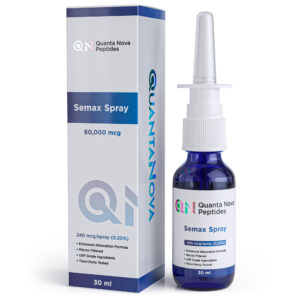Description
Product Overview
QuantaNova’s Hexarelin 5mg (4-pack) features a high-purity lyophilized peptide manufactured in the USA and tested by ISO certified Vanguard Laboratory for identity, purity, quantity, and endotoxins. This peptide comes in four 5mg vials of lyophilized powder and is stabilized using our proprietary lyophilization method to preserve peptide potency during transit and storage. Each batch of Hexarelin is micron-filtered using PES 0.22μm filtration to eliminate any possibility of contaminants, ensuring a (LPS Free) product. QuantaNova’s in-house lyophilization and production protocols ensure a high standard of quality control and structural preservation across all peptide batches.
Hexarelin Peptide Structure
- Sequence: His-D-2-methyl-Trp-Ala-Trp-D-Phe-Lys-NH₂
- Molecular Formula: C₄₇H₅₈N₁₂O₆
- Molecular Weight: 887.04 g/mol
- CAS Number: 140703-51-1
Key Findings of Hexarelin
- Studied for its potential to stimulate growth hormone (GH) secretion in research models
- Explored for its effects on muscle hypertrophy and recovery in tissue regeneration studies
- Investigated for cardiovascular research, including effects on left ventricular function
- Researched for metabolic applications related to fat mass and energy regulation
In-Depth Research Applications of Hexarelin
Hexarelin, a synthetic hexapeptide and growth hormone-releasing peptide (GHRP), has been extensively studied for its role in stimulating GH release via the pituitary gland. Unlike natural GH secretagogues, Hexarelin exhibits enhanced stability and receptor affinity, making it a preferred model in studies involving GH axis modulation.
Endocrine and Anabolic Research
Research shows that Hexarelin may trigger a strong GH release by binding to the GHS-R1a receptor. This pathway plays a critical role in anabolic responses, including muscle regeneration and lean mass development. Laboratory models often explore how Hexarelin’s GH-releasing effects may support recovery protocols and skeletal muscle growth under various experimental conditions.
Cardiovascular Research
Hexarelin has been studied for its influence on heart tissue, particularly its potential to protect cardiac cells and improve ventricular performance. Animal models have explored their cardioprotective effects in ischemia-reperfusion scenarios, suggesting their relevance in myocardial recovery studies.
Metabolic and Fat Tissue Studies
Beyond GH stimulation, Hexarelin may play a role in lipid metabolism. Research has shown that it may affect adiposity levels and influence overall energy balance. This makes it a peptide of interest in obesity and metabolic disorder models.
Neuroendocrine Effects and Protective Properties
Hexarelin has also been studied for its interaction with ghrelin receptors in brain tissue. These studies aim to uncover its potential neuroprotective properties and influence on stress-related hormone regulation, such as cortisol and ACTH levels, in experimental settings.
Across various research studies, Hexarelin continues to be recognized for its well-characterized mechanism and stable profile, offering a reliable compound for exploring GH modulation, tissue repair, and neuroendocrine signaling.
Resources
-
Cardiovascular Research
-
Metabolic and Fat Tissue Studies
-
Neuroendocrine Effects and Protective Properties
Usage & Storage Guidelines
- Handle using appropriate laboratory safety procedures.
- Storage (Lyophilized): Store at -20°C.
- After Reconstitution: Store between 2–8°C and use within 14–30 days.
- Diluent Recommendation: Reconstitute with bacteriostatic water or a suitable research-grade diluent.
Legal Disclaimer
This product is intended strictly for laboratory research purposes only. It is not a drug, food additive, cosmetic, or therapeutic substance, and must not be used in humans or animals. It is the buyer’s responsibility to handle the product safely and in accordance with applicable laws and regulations.










Reviews
There are no reviews yet